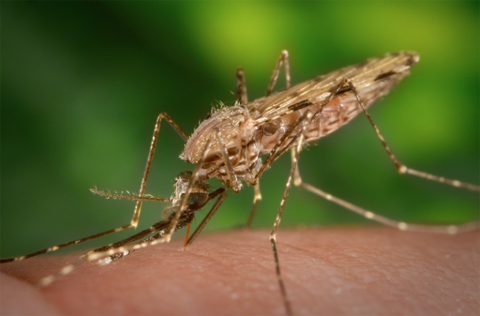A molecule that prevents the immune system from attacking cancer may play a similar role with malaria. A new study by researchers at the University of Iowa Carver College of Medicine shows that targeting the molecule at the right time during infection allows mice to quickly clear malaria. Importantly the treated mice also develop lasting immunity to malaria.

“People have long known that malaria is associated with a huge immunosupressive response, but no one knew the mechanism,” say Samarchith (Sam) Kurup, PhD, a UI assistant research scientist and first author on the study.
“The CTLA-4 molecule interferes with appropriate immune activation,” explains John Harty, PhD, UI professor of microbiology and immunology and senior study author. “Specifically, it interferes with the function of several types of T helper cells whose job it is to drive immune responses against malaria.”
Malaria is a serious, life-threatening disease across most of the developing world. There are 200 million cases of malaria each year and almost 500,000 malaria-related deaths. The malaria parasite, which is transmitted by mosquito bites, persists in the blood for long periods. Critically, although there are drugs that can cure the infection, humans do not develop immunity to infection, which means a person can get reinfected with malaria year after year. Multiple infections eventually make a person resistant to the severity of the disease symptom, but when the person – usually a young child – experiences their first few infections, the disease can be deadly.
Video summary
The video below shows cells moving inside the spleen of a mouse. UI researchers have been studying why people with malaria can get re-infected with the disease again and again, and believe they’ve homed in on a possible culprit. The green cells are shedding a molecule called CTLA-4 onto the blue, magenta, and red immune cells. This prevents the immune cells from efficiently producing antibodies against malaria. If this pathway works in humans as it does in mice, blocking CTLA-4 might be a way to improve malaria treatment and boost immunity to reinfection.
Video credit: Samarchith Kurup, Scott Anthony, Department of Microbiology and Immunology, University of Iowa
Malaria meddles with immune responses

That doesn’t happen in malaria. Instead, there is a period where the T helper cell expansion stalls. During that critical time period, the UI reseachers showed that the Treg population increases.
“Our observation that the Tregs went up when the T helper cells stopped going up showed a timing relationship that suggested the possibility of a functional relationship,” says Harty, who also is a UI professor of pathology.
When the UI team eliminated Treg cells in mice with blood-stage malaria infections, the expansion of the T helper cells did not plateau; they kept expanding and cleared the infection faster.
Further experiments revealed that Tregs suppress the normal immune response by continuously expressing and shedding the CTLA-4 molecule, which interferes with the normal immune function of T helper cells. It also interferes with another set of T helper cells (follicular T helper cells) whose job it is to help make antibodies against malaria.
“Tregs meddle with these processes through the CTLA-4 molecule,” Harty says.
Blocking CTLA-4 at the right time during blood-stage infection cured mice of the infection and promoted immunity against reinfections. It even provided protection against challenge from another deadlier malaria parasite.
Previous work in Harty’s lab found that blocking a different checkpoint protein called PDL1 at a later point in malaria infection also improved the host immune response to malaria. The new work shows that the CTLA-4 pathway is in play at an earlier stage in malaria infection, and shows that the two pathways don’t overlap.
“Both pathways impede the appropriate activation of the immune system, but in different ways, targeting different interactions, and at different time points,” Harty says. “The more we understand how and when these pathways are operating, the better chance we have to rescue them.”
Of mice and men
Harty and Kurup are quick to point out that findings in mice often do not translate easily to human patients, but access to unique human data may help determine if the CTLA-4 findings are relevant in humans.
For about a decade, Harty has collaborated with Peter Crompton, an National Institutes of Health (NIH) scientist who works with malaria patients in the African country of Mali. The clinic where Crompton’s colleagues work tracks around 700 children year after year. During each wet season, when malaria is endemic, children are diagnosed and treated for malaria, and the team collects blood samples for immunological studies.
“This has been a very potent resource for us,” Harty says. “When we look at blood samples from the same infection timeframe that we investigated in the mouse, we see some of the same immune changes (expansion of Tregs and upregulation of CTLA-4) are also happening in humans. That does not prove that everything is the same, but at the level of resolution that we have, there is some reasonable similarity.”
“Practically, we have shown there is a pathway that can be targeted, and although CTLA-4 blockers that are available as cancer immunotherapies are too costly and impractical to use for malaria, there may be other parts of this immunological pathway that could be targeted using other drugs or small molecules, to produce the same effect,” Kurup says.
The malaria parasite is adept at developing resistance to antimalarial medicines that target it directly, as has happened time and time again. The UI approach focuses on modulating or improving the immune response of the host.
“The parasite can’t become resistant to that,” Harty says.
In addition to Harty, Kurup, and Crompton, the research team spread between UI, NIH, and Mali, included Nyamekye Obeng-Adjei, Scott Anthony, Boubacar Traore, Ogobara Doumbo, and Noah Bulter. The research was funded in part by grants from the National Institute of Allergy and Infectious Diseases the National Institute of General Medical Science of the NIH.